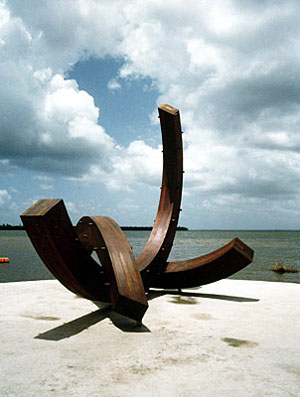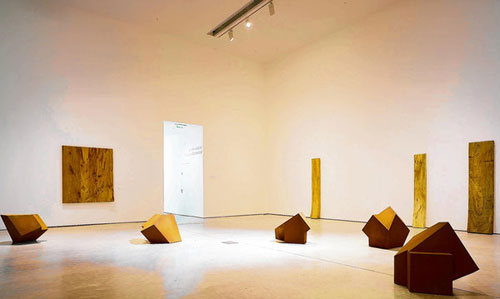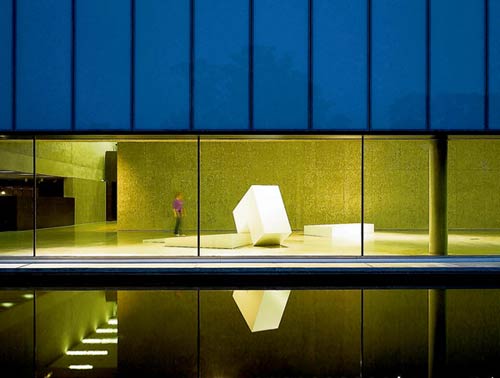
 Sculpture News at SculptSite.com
Sculpture News at SculptSite.com
Michael Warren Sculpture |
 Alizes et tortues |
| IRISHTIMES.COM by AIDAN DUNNE Michael Warren thinks big, and yet - as his show at Carlow Visual proves - even his most imposing work doesn't lose its humanity, writes AIDAN DUNNE UNBROKEN LINE is the first time the substantial spaces of Carlow's Visual Centre for Contemporary Art, inside and out, have been devoted to displaying the work of a single artist. That artist is the Wexford-born sculptor Michael Warren, 60 this year, and if you haven't already paid a visit to Visual, his show, which includes a substantial body of new work as well as a retrospective survey extending back to 1969, provides a compelling reason to do so. It's complemented by another exhibition of his recent work, Kireji, at Hillsboro Fine Art in Dublin. Even if you haven't been to a gallery you've probably seen work by him - outside the Civic Offices on Wood Quay, in the grounds of Trinity College, at the RTÉ studios in Montrose or in many other locations - as he has made an impressive number of publicly sited sculptures. He has always thought big, and some of his largest projects are installed abroad, in France, Spain, Portugal and as far afield as Japan and Ecuador. The earliest sculpture in Unbroken Line is a carved-wood Torso . It's a spare, elegant, abstracted piece of figuration, remarkably sure in form and feeling given the artist's relative youth. There's nothing else that looks as definitely figurative in the exhibition, yet there clearly is an unbroken line between it and the most recent works on view. More, it shows us how we might look at them. A cursory glance could suggest Warren is an abstract artist, pure and simple, concerned with form, not content. "Whenever I have attempted figurative sculpture I have found it too specific," he says. All the same, in his work he has always been engaged with existential and metaphysical ideas, with embodiment and the human predicament. Visual's huge main gallery houses just six columnar blocks of solid, quite coarse-looking opepe wood. The blocks are variously incised with vertical or horizontal indents, giving each one something of a personality, but they are minimally worked and all the cuts are geometrically straight. They're big, imposing, impassive presences, and you can feel their mass and weight when you look at them and walk among them. It may sound perverse to say they come across as being six human presences, rather than six blocks of wood, but they really do. And Warren clearly intends this. He calls them Caryatid I-VI after the sculpted, usually female, figures that served as architectural supports in ancient Greece. The emphasis on the materiality of the human being and the symbolism implied by the supporting role are very characteristic of what he does. In the smaller Studio Gallery at Visual are six more wooden "figures", this time titled Sei Personaggi , referring to Luigi Pirandello's play Six Characters in Search of an Author . The characters loom in the more confined space, in a slightly uncomfortable way, and they are given greater variety of presence in the shaping of the wood and by virtue of the fact that several different woods are used. Outside this room are several painted-steel sculptures. If the wood sculptures are the characters, the steel pieces are the stage: platform-like horizontal constructions that invite performance (in fact there will be a performance there, on November 3rd, when Irish Modern Dance Theatre brings its work Actions to the space). Warren has used many materials over the years, but, as Rod Mengham observes in an essay on his work: "The material that he started out with, and that he has turned to more often than to any other, is wood." It suits him because of its combination of qualities. It can be machined to produce geometric forms, even on a monumental scale, but it is also a richly variable organic material susceptible to myriad natural processes: it shrinks, cracks, bends, weathers. Warren is drawn to this duality. His wooden pieces embody struggle, endurance and heroism, bringing to mind Immanuel Kant's remark that "no one ever made anything straight out of the crooked timber of humanity". There is always an elemental struggle in the sculptures, enacted on the vertical and horizontal planes: a striving upwards, a dragging down. As he notes: "Where the sculpture is predominantly horizontal the overhead space reads as a downward pressure." Again, this is not to do with a study of gravitational effects; rather, it is about being alive. The writings of the philosopher and mystic Simone Weil were a formative influence, especially her thoughts collected posthumously in Gravity and Grace . "Weil sees attention as a sort of metaphysical counterweight," Warren says in an interview with John Daly. "Especially when it is directed towards inert matter. Sculpture, it seemed to me, is particularly well positioned to explore this promise of redress, what she calls 'moral gravity'." It's a good description of his work. Born in 1950, Warren attended St Columba's College in Rathfarnham, which he found enlightening and enlivening, and was encouraged in his interest in sculpture by the late Frank Morris, under whose guidance he made his first carving, the Torso included in Unbroken Line. He went on to Bath Academy and then, abortively, to Trinity, where he included philosophy in his studies. "Midway through the academic year I knew I'd made a mistake. For me philosophy had always been about finding out the best way to go about living. The history and development of thought were of no real interest." Instead he studied sculpture in Milan under Luciano Minguzzi and began to visit Spain, where he met the sculptor Eduardo Chillida, whose work has been an important influence. In Ireland in the mid-1970s he encountered the architect Ronnie Tallon. Tallon is exceptional in his record for commissioning sculpture in relation to architectural projects and was aesthetically responsive to Warren's vision. They have enjoyed a long, fruitful association, the most remarkable result of which is the great Tulach a'tSolais on Oulart Hill, in Co Wexford, an epic work of environmental sculpture. Given that a great deal of Warren's work is site-specific and fairly immovable, Unbroken Line is the ideal opportunity to get a sense of what he is about in one capacious and convenient venue. It also displays the extraordinary potential of Visual as a complex of exhibition spaces without par in Ireland. |
 "my sculpture, like Chinese script, reads downwards: limit is imposed by space; space has weight. Void is emptiness filled with space, sculpture, the ratio of space to matter-the awareness of limit." Michael Warren, 1987 No one could say it any better. Michael is a master at space with wood. His work with wood has always kept me in awe... I wish I had a humungous plane so everyone could fly to Ireland to see this exhibition of his work! |
 |
 |
More Sculpture News ....
Submit your SCULPTURE NEWS.
It's easy, just send us an e-mail
(click on Submit News in the left menu) with your pertinent information along with images, we'll take care of the rest. Sculpture makes our world a much better place in so many ways!
SculptSite.com, along with Sculptors and their creative genius all helping to bring the beauty and message of Sculpture to a hurried world.

